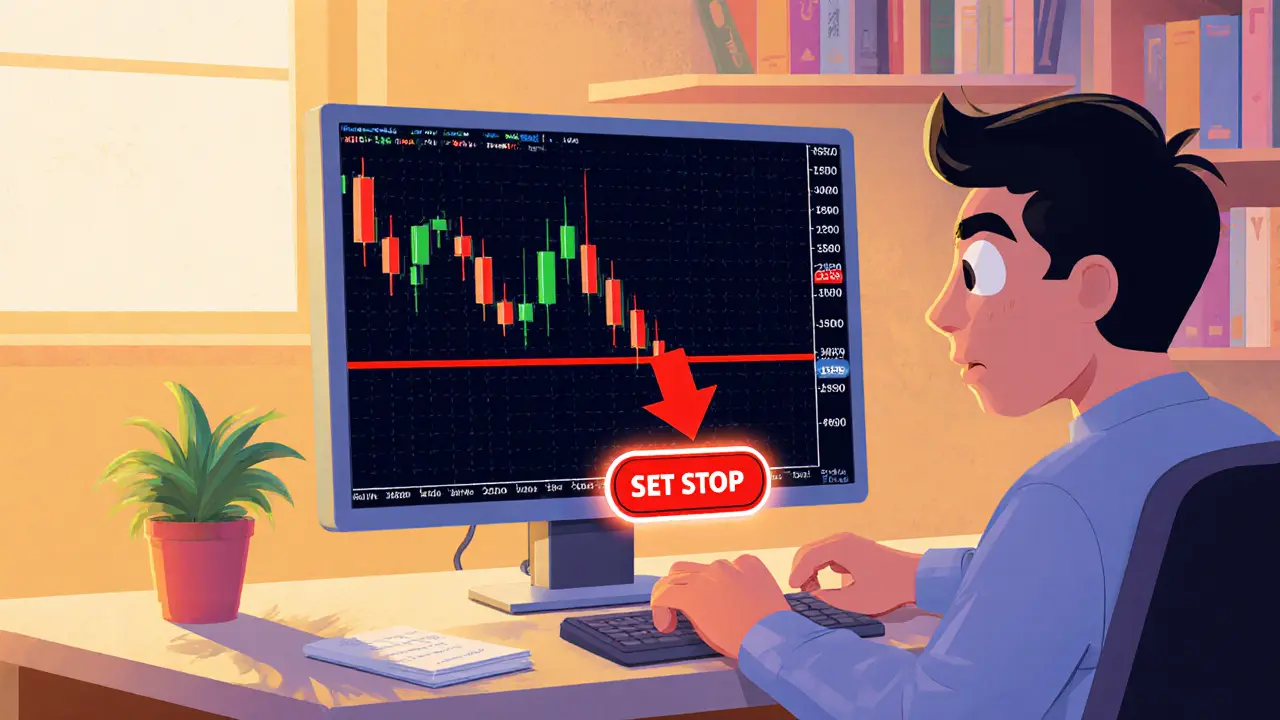
- 24 Sep 2025
- Elara Crowthorne
- 18
Stop-Loss vs Trailing Stop Calculator
A fixed price level that triggers a sale when the market reaches it. Ideal for volatile markets and short-term trades.
A dynamic stop that moves with the market price. Great for trending markets and long-term trades.
Enter your trade parameters and click "Analyze Trade Protection" to see which order type offers better protection for your situation.
When you trade, the big question is how to keep a loss from wiping out the win. Two tools dominate the conversation: the stop loss and the trailing stop. Both are designed to protect capital, but they work in opposite ways. This guide walks you through what each order does, when it shines, and how to blend them for a smoother trading life.
What a Stop-Loss Order is looks like
A Stop-Loss Order is a fixed instruction to sell a security once its price falls to a preset level, locking in a maximum loss. You set the trigger price when you open the trade, and it stays there until the market hits it. Once triggered, the order becomes a Market Order an order that executes immediately at the best available price. The key point is that the stop price never changes unless you manually edit it.
How a Trailing Stop Order works
A Trailing Stop Order is a dynamic order that moves the stop price in the trader’s favor as the market rises (for longs) or falls (for shorts). You specify a distance - either a dollar amount or a percentage. As the price climbs, the stop price “trails” behind it, never moving backward. If the price reverses by the set distance, the order flips into a Market Order and sells at the prevailing price. The effect is a built‑in profit‑locker that still protects against a sudden drop.
When a Stop-Loss Order shines
- Volatile or uncertain markets - If you’re trading a currency pair that jumps around, a fixed stop gives you a hard ceiling on loss.
- Scalping or day‑trading - Rapid, short‑duration trades need an exit that’s set once and forgotten.
- Limited platform support - Almost every broker, even the simplest ones, handle stop‑losses without a hitch.
Because the stop level is set in stone, you avoid the temptation to keep moving it higher when the trade looks good. That discipline can be a psychological lifesaver.

Where a Trailing Stop Order adds value
- Trending markets - When a stock or crypto token is on a clear uptrend, a trailing stop lets you ride the wave while automatically locking in gains.
- Swing and position trading - These longer‑horizon styles benefit from a “set‑and‑forget” profit guard that adjusts as the price moves.
- Algorithmic strategies - Bots can monitor price changes and update the trailing distance in real time, eliminating manual tweaks.
The trade‑off is that in a choppy market, the trailing stop may fire on a normal pullback, cutting you out of a trade that would have continued upward.
Side‑by‑side comparison
| Feature | Stop‑Loss Order | Trailing Stop Order |
|---|---|---|
| Trigger type | Fixed price level | Dynamic price level (percentage or dollar amount) |
| Adjustment | Manual only | Automatic upward (or downward) movement |
| Best market condition | High volatility, short‑term trades | Strong trends, swing/position trades |
| Platform requirement | Supported by virtually all brokers | May need advanced platform or API access |
| Psychological impact | Clear loss ceiling reduces stress | Can cause anxiety when profits vanish on a pullback |
How to choose the right tool for your trade
Start by answering three quick questions:
- Is the asset in a clear trend or bouncing around? If it’s trending, lean toward a trailing stop.
- How much time do you plan to stay in the trade? Short‑term? Use a fixed stop‑loss.
- Does your broker support real‑time price monitoring? If not, stick with the simpler stop‑loss.
Most professionals don’t pick one over the other; they layer them. A common pattern is:
- Set an initial Stop-Loss Order at a loss‑tolerant level when the trade opens.
- Once the position is in profit by, say, 3‑5%, replace the stop‑loss with a Trailing Stop Order set at a 2‑4% distance.
This hybrid gives you a safety net on the downside while letting gains run.
Special considerations for different markets
Both order types behave slightly differently in Cryptocurrency Market a 24/7, highly volatile market where prices can swing 20% in a single day versus the Forex Market the global currency market known for tight spreads and high liquidity. In crypto, the constant price feed makes trailing stops attractive, but extreme volatility can also trigger them too early. In forex, spreads are thin, so a fixed stop‑loss can be placed very close to entry without a huge risk of slippage.

Implementation tips for algorithmic traders
If you write bots, keep these rules in mind:
- Always monitor the highest price reached since the order was placed - that’s the reference for the trailing distance.
- Use a price buffer (e.g., 0.5% wider than your target) to avoid being taken out by normal market noise.
- Log each adjustment; you’ll need the data for post‑trade analysis.
- Test on a sandbox or paper‑trading account first - some platforms treat trailing stops differently under high‑frequency conditions.
Common pitfalls and how to avoid them
Premature triggering: In a choppy market, a tight trailing distance can fire on a temporary dip. Solution - widen the distance or combine with a moving‑average filter.
Slippage on execution: Both order types become market orders once triggered, which can lead to execution at a worse price during rapid moves. Solution - use a Limit Order an order that executes only at a specified price or better as a backup if your broker offers “stop‑limit” functionality.
Platform limitations: Not every broker lets you place trailing stops on all asset classes. Solution - verify support for the specific market (crypto, stocks, futures) before relying on it.
Bottom line
If you need a hard ceiling on loss and trade on fast‑moving, noisy assets, a plain stop‑loss is your go‑to. If you want to stay in a strong trend while automatically protecting gains, the trailing stop is the better fit. Most successful traders blend both, using a stop‑loss for initial protection and swapping to a trailing stop once the trade is comfortably in profit.
Frequently Asked Questions
Can I use a stop‑loss and a trailing stop on the same trade?
Yes. A common practice is to set a fixed stop‑loss at entry, then replace it with a trailing stop once the position is in profit. This gives a safety net on both sides.
Do trailing stops work on short positions?
They do. For short trades the stop price trails upward as the price drops, keeping a set distance above the lowest price reached.
What’s the main cause of slippage with these orders?
Both turn into market orders when triggered, so if the market moves quickly the execution price can be worse than the stop level. Using a stop‑limit order or trading on a liquid exchange can reduce this risk.
Are trailing stops suitable for cryptocurrency day‑trading?
They can be, but crypto’s extreme volatility may cause frequent premature exits. If you day‑trade, a tighter fixed stop‑loss is often more reliable.
How often should I adjust my stop‑loss level?
Ideally, never. The point of a stop‑loss is to set it once and forget it. Adjust only if your trade rationale changes dramatically.

18 Comments
Great overview! The distinction between a fixed stop‑loss and a trailing stop really matters when you’re dealing with fast markets. Stick to one method until you feel comfortable, then experiment with the hybrid approach.
Whoa, this guide is like the blockbuster sequel to every "how‑to" post we’ve seen! The way you broke down volatile versus trending markets feels like a drama on a trading floor. I love the visual tables – they’re practically a stage set for the epic battle of stops. The hybrid suggestion? Pure genius, like a plot twist nobody saw coming. Readers will definitely binge‑read this, especially those who love a good financial thriller.
Interesting read, very thorough, and it really helps clarify that a stop‑loss is static, whereas a trailing stop moves with the market; this distinction is crucial, especially for newer traders, and the examples you provided illustrate the concepts well, plus the tables are nicely formatted, making the comparison easy to digest.
Thanks for the clear guide! 😊 I especially appreciate the emoji‑friendly tone – it makes the heavy stuff feel lighter. The sections on crypto versus forex are spot‑on, and the tip about using a stop‑limit to cut slippage is golden. 🌟 Keep the good vibes coming!
This is a solid primer for anyone confused about order types. The language is simple enough for beginners, yet it still covers the technical bits. I like how you suggest starting with a fixed stop and then switching to a trailing stop once you’re in profit. That hybrid method works well in many markets.
Reading this feels like a quiet walk through a garden of trading concepts. The philosophical angle of “setting a ceiling on loss” resonates deeply; it reminds us that discipline is the most valuable tool. Your breakdown of market conditions aligns with the classic risk‑reward balance. It’s a nice reminder that every tool has a purpose, and choosing wisely is an art.
Solid article-definitely a must‑read for active traders!!
Wow, this post is like a colourful paintiing of the trading world! The way you compare fixed stops to moving stops is super clear-no more head‑scratchings. I love the practical tip about using a stop‑limit to dodge slippage, really helps avoid nasty surprises. Also, the hybrid approach sounds like mixing the best of both flavors-delicious! Keep dropping these gems, they'll help many of us avoid nasty losses.
The guide does a good job of walking through each order type step by step. I appreciate the calm tone, especially when describing the risks of premature triggers. It’s helpful to see the concrete numbers for stop‑loss and trailing‑stop levels. This will make setting up trades smoother for many.
People need to understand that reckless trading without proper stop strategies is immoral. Using a well‑placed stop‑loss is a responsibility we owe to ourselves and the market.
Whilst the exposition herein is commendably thorough, one must question the underlying assumption that trailing stops are universally superior in trending markets. It is a widely held, yet perhaps naïve, notion that market momentum will always favour the investor’s position. In reality, the stochastic volatility inherent to modern markets can subvert even the most robust trailing mechanisms. Moreover, the conversation neglects the latency introduced by broker APIs, which may render theoretical advantages moot. The author, therefore, ought to temper optimism with a sober appraisal of execution risk. Such a balanced discourse would better serve the discerning reader.
Use a stop‑limit if you’re worried about slippage.
Let me tell you why the whole “stop‑loss vs trailing stop” debate is a smokescreen engineered by the elite financial elite to keep us all in line. First, every broker you trust is secretly feeding your trade data through back‑doors, altering your execution prices before you even see them. Second, the algorithms that power trailing stops are calibrated to trigger just before a major price surge, siphoning off the profit that should belong to you. Third, the very concept of a “hard ceiling on loss” is a myth; hidden liquidity pools and dark pools allow large institutions to absorb your stop orders without moving the market, effectively erasing the safety net you think you have. Fourth, the volatility metrics they present are cherry‑picked; they ignore the micro‑spikes that cause instant liquidation. Fifth, the so‑called hybrid approach is just a fancy way to double‑dip into your capital, making you pay fees twice. Sixth, the recommended distance percentages are calibrated to the average retail trader’s risk tolerance, which is purposely set low so you never truly profit. Seventh, the “stop‑limit” solution you’re told to use is often a dead‑end; many platforms don’t even support it for the assets you care about, leaving you with a default market order that can be filled at a wildly different price. Eighth, the whole system thrives on the fear of missing out – you’re constantly chasing the next “trend” because the platform nudges you with pop‑ups and alerts. Ninth, consider the data latency: price feeds are delayed by milliseconds that matter in high‑frequency trades, so your trailing stop might be a step behind when it finally triggers. Tenth, the psychological “discipline” narrative is a cover for the fact that you’re being conditioned to accept loss as normal, while the big players profit from the churn. Eleventh, the regulatory bodies have been warned multiple times about these practices, yet they remain silent, indicating a collusion of interest. Twelfth, the article itself overlooks the role of market makers who manipulate price levels to hit stop orders precisely. Thirteenth, the recommended “2‑4%” trailing distance is based on historical data that no longer applies in today’s algorithm‑driven markets. Fourteenth, there is an entire industry of “stop‑loss insurance” products that are sold as add‑ons, siphoning off a portion of any gains you might make. Lastly, remember that every time you set a stop, you are essentially handing a piece of your strategy to the market’s invisible hands, allowing them to dictate the terms of your trade. The truth is, no order type can protect you fully; the only real shield is staying out of the market until the system reforms.
That was a wild ride through the hidden layers of trading! Even if you’re skeptical, the advice to start simple and add complexity gradually still holds. Keep experimenting, but always stay aware of the bigger picture.
Your thorough breakdown is appreciated, especially the sections on slippage and stop‑limit usage. Remember to test any hybrid strategy in a demo environment before risking real capital. Also, keep an eye on broker execution policies, as they can vary widely. This will help you avoid the pitfalls highlighted earlier.
Honestly, the whole system feels rigged, but if you have to trade, use the simplest tools. A tight stop‑loss can keep you alive, and a modest trailing stop helps ride the trend. Don’t get too fancy; the bots will outsmart you.
Keep it simple and stick to a fixed stop.
From a risk‑management perspective, the fixed stop acts as a hard stop‑loss buffer, while the trailing stop provides a dynamic profit‑capture mechanism. Implementing a tiered exit strategy-initial fixed stop followed by a trailing stop-optimizes the trade lifecycle. Ensure your platform’s API supports real‑time order modification to avoid latency issues.